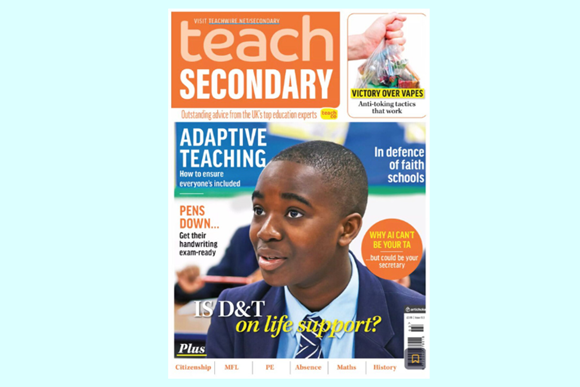Is a ‘business as normal’ approach to the NEA the first tentative step towards establishing a new reality?
Published 23rd May 2020
Context
I should start by acknowledging that we are in not only unprecedented but also very fast-moving times. Those in positions of responsibility are tasked to make impactful decisions as the ground around them is metaphorically shifting. In such times all we can ask is that system leaders are driven by the right values and have a set of outcomes in mind that will benefit the majority, not the few.
Whatever one thinks of the decisions made around how this summers GCSE and A Level results will be awarded; I was fortunate to be included in consultation meetings and was able to represent our members views. I left wholly assured that Ofqual was not only in possession of the required facts and data but was driven by the overriding principle that no student should be disadvantaged by the current circumstances.
It is a fact that every educator will contest to, that sadly students are not competing on a level playing field. The attainment gap between those that have and those that have not is wider in the UK than in many of our European counterparts. Disadvantage can stem from socio-economic background, individual learning needs, parental attitudes to the value and importance of education etc. Once students fall behind their peers, they can quite literally spend the rest of their lives playing catch-up.
The COVID-19 pandemic and the resulting closure of schools and move to home education, has disadvantaged some of our most deprived young people. While some students have found the lockdown and resulting autonomy of learning liberating; for others, learning stopped for them in mid-March. Any decisions made now around how we restart education must have the needs of these students at the very forefront.
The importance of retaining non-examined assessment in D&T
When the current GCSE was developed leading out of the 2014/15 curriculum review, the Association played a leading role in both assembling a group of experts whom the DfE could consult and actively engage, and also represent the views and experiences of its members. The battle to retain an element of coursework was fought and won (the desirability of this was far from universally accepted at the time) and although its contribution was reduced from 60% to 50%, what emerged as the Non Examined Assessment (NEA) component, the contextual challenge, is now generally agreed as being a much valued and successful evolutionary step.
Learning, assessment or both?
It would be a mistake to think of the NEA in our subject only as an assessment instrument. Embarking on one of the annually published contextual challenges provides an authentic and rich learning experience. In fact, as the time taken concentrating on completing the challenge represents such a significant component of the allocated study time, it would be foolish to consider it otherwise.
Learning in the years building up to engagement with the NEA should prepare students to use the challenge set to demonstrate their ability to identify and analyse a problem, collect and generate a body of evidence that informs their designs and guides their design direction. Students should then be able to model ideas and generate possible solutions which they will check against a determined brief and specification before honing a solution towards a final prototype that can be tested with the original user(s) feedback.
To successfully tackle this task students need to lean on what they have learned in the years building to this challenge, while at the same time, to complete it, students have to explore new concepts and venture into the unknown. In summary, they need to utilise what they have already learned to lead them to new concepts and new areas of learning.
The importance of concentrating on what we can control.
One can quite easily create a long list of reasons why it is not possible or desirable to start the NEA Contextual Challenge from June 1st. Not all students will be able to engage; students will not have access to specialist tools, materials and machinery, without guidance in the initial stages’ students may go off at a tangent, I cannot adequately support the least able from a distance...I could go on.
Let’s look at this differently. If you cut out or diminish its contribution, (in this case by delaying its introduction) one impacts massively the educational opportunity the qualification is intended to provide. Completing the NEA task offers a perfect example of how learning on a ‘need to know’ basis, matched to an individual task takes place, given increased gravitas as the overall efficacy of response submitted equates to tangible benefit, i.e. a GCSE grade. This is motivational in a way that completing other tasks set internally by the teacher can arguably never be.
Designers often test initial concepts by reaching out for information and opinion. In these troubled times, there is an argument that it may be possible to gather a much higher level of engagement from people who are far more active online than they may have been before the lockdown. The lack of machines and specialist tools may force students to think creatively as to how they can model and test initial ideas using simple artefacts found around the house. For those with digital access, most CAD tools are downloadable free from the Internet, with simple reference to YouTube tutorials, students can be developing ideas within hours.
Those without digital access can still engage in investigative activities, sketching, designing and prototyping. It is important that no students are left out of the learning process, so a range of activities digital and paper based, need to be presented. Hitting students with a wall of positivity as to the learning opportunity that this challenge presents could, in fact, set creative minds free.
Staying compliant with assessment regulations
All of the awarding organisations will require teachers to vouch for the integrity of NEA work carried out at home. In other words, is the quality of work presented in line with the work that they have seen from this student previously? If there are signs of significant improvement, what conversations have been had with the student that satisfies the teacher that this work genuinely belongs to the student concerned. Initial modelling and prototyping can be carried out at home and photographed with a Smartphone. Email and written communication with clients can be saved and included as evidence. If students cannot digitally join Zoom or MS Team calls to check and guide progress, go ‘old school’ and call them.
The only part of the Contextual Challenge that cannot be made at home is the final prototype that needs to be made under teacher supervision. But that is some way away and who knows what might be possible by this time?
Will all awarding organisations be releasing on June 1st?
Under normal circumstances, whatever decisions are made regarding release dates, all awarding organisations have to work together. We can confirm that in the week ending 22nd May, all awarding organisations have been permitted to release their challenge when they feel it is most appropriate for their schools and students. At the time of writing, only one, AQA, has made and announced a firm decision to release on June 1st; the others are still discussing options with decisions imminent.
I can assure you all that everyone involved in decision making around this is taking their responsibilities seriously, from the DfE (setting subject content), Ofqual (regulating examination content) JCQ (developing common guidance and regulations for exam regulations) and of course, the awarding organisations. Decision made and soon to be made have been the subject of a significant number of high-level discussions. Within these discussions’ students’ needs are the very first consideration.
The bigger picture
While we are understandably primarily concerned with how to manage our subject and our students, we should be mindful that we are not the only subject suffering restricted activity due to the pandemic. PE practical’s (an essential part of GCSE and A Level assessment) cannot take place until team sports are allowed again, drama productions cannot happen, Art and Design activities are curtailed, Health and Nutrition activities cannot take place until kitchens open again. It is essential to acknowledge that our position while challenging, is not unique.
Guidance on how to allow a safe return to workshops
The CLEAPSS advice issued just over a week ago is accurate and has been carefully thought through. We work closely with our colleagues at CLEAPSS, and there is no doubt that reopening schools and workshops will be challenging and will require lateral thought.
If we can only get a limited number of students into a workshop at any given time, we may need to timetable differently, run support sessions after school and maybe even at weekends; almost anything is possible with a degree of flexibility. Remember that for the NEA supervised making, we are some months away from having to arrange this, who knows what may or may not be possible by this time. Let’s concentrate on what we can do to enable learning now; accepting that we will need to pause, reflect and adjust as we progress.
We will be issuing thoughts and observations on reopening schools and workshops on Thursday 28th May. It does concern me that some schools are reporting that decisions have been made that all D&T will be classroom-based for the foreseeable future once schools return; ours is a practical subject, we cannot deliver it in classrooms alone.
I have every confidence that whatever happens going forwards, the respective authorities will continue to work dynamically to protect all students. At the Association, we have complete faith in D&T teachers’ ability to manage the demands of the current crisis, as a community we are both adaptable and pragmatic by nature. Engaging with the NEA as soon as possible is the right thing to do as we attempt to create a positive environment for student learning and progression.
Tony Ryan
CEO Design and Technology Association
Back to News


